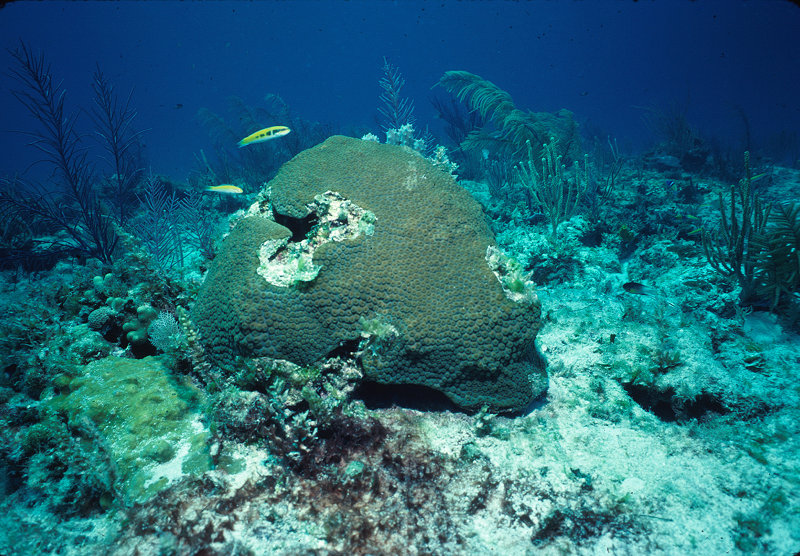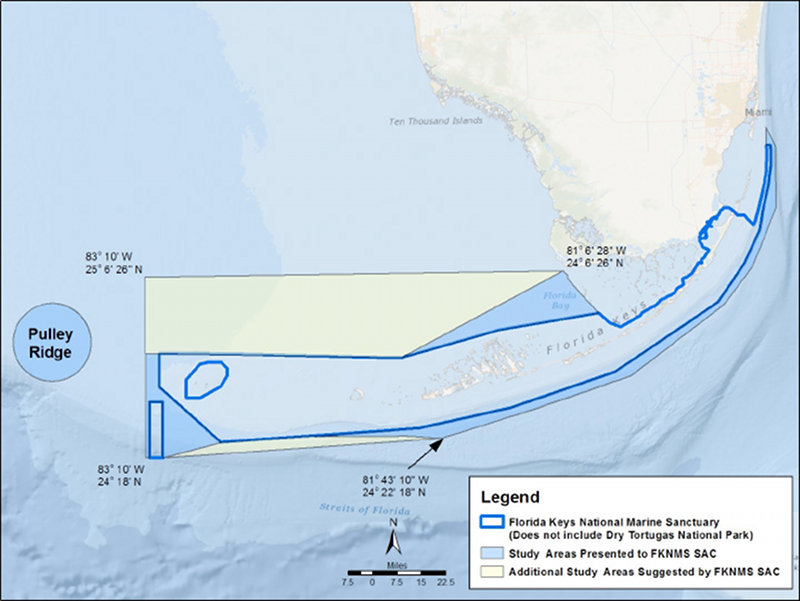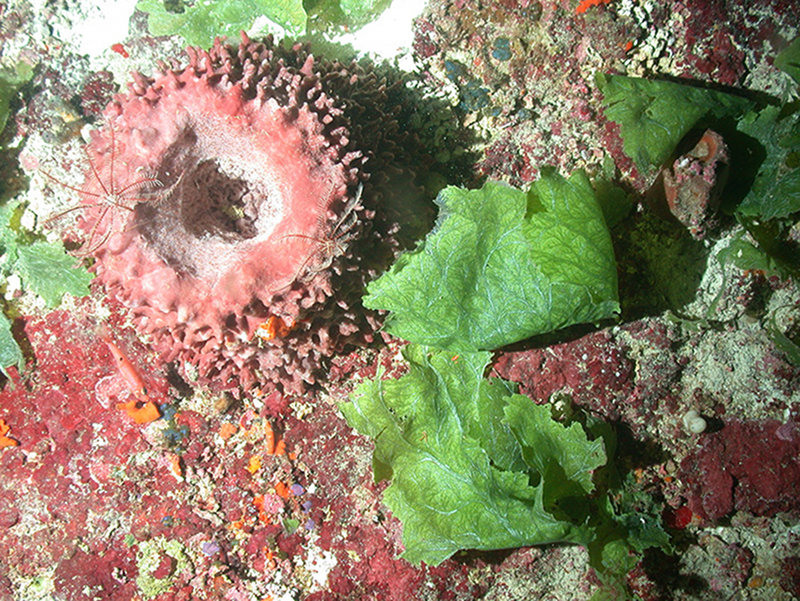
Sean Morton, Superintendent
Beth Dieveney, Deputy Superintendent
NOAA Florida Keys National Marine Sanctuary

Shallow water colony of the great star coral, Montastraea cavernosa, in 15 feet of water. The great star coral is one of our target species and is found at both Pulley Ridge and in the Florida Keys. We are trying to understand if the two populations are connected genetically. Image courtesy of John Reed. Download larger version (jpg, 2.3 MB).
The waters of the Florida Keys boast spectacular coral reefs. Much of this reef ecosystem, which plays an integral role in the tourism-based economy of the Keys, is protected by the Florida Keys National Marine Sanctuary. Designated in 1990, the sanctuary protects 2,900 square nautical miles of Florida Keys waters using an approach that combines public input and scientific and socioeconomic data to develop projects and programs that address sanctuary impacts, pressures, and threats.

This map depicts the areas, including Pulley Ridge, under study by the Sanctuary Advisory Council for potential inclusion into the Florida Keys National Marine Sanctuary. Image courtesy of NOAA Florida Keys National Marine Sanctuary. Download image (jpg, 76 KB).
Pulley Ridge, the deepest known photosynthetic coral reef off the continental U.S., is situated approximately 33 miles northwest of the Florida Keys National Marine Sanctuary. The proximity of Pulley Ridge to the sanctuary, combined with the influence of the Loop Current, has led scientists to question whether Pulley Ridge could serve as an upstream source of invertebrate and fish larvae for the sanctuary. Understanding the degree to which these coral ecosystems are connected and have resources in common is key information that managers need to protect reef ecosystems.
In 2005, through the Essential Fish Habitat authority of the Gulf of Mexico Fishery Management Council, Pulley Ridge was designated as a Habitat Area of Particular Concern (HAPC). Areas can be designated as HAPCs if the area is rare, particularly susceptible to human-induced degradation, especially ecologically important, or located in an environmentally stressed area.
Pulley Ridge is both rare and especially ecologically important and under some circumstances (e.g., oil spills) may be environmentally stressed. Specific fishing regulations in place within the HAPC prohibit bottom anchoring by fishing vessels, bottom trawling, longlines, buoy gear, and all traps/pots. HAPC designation does not protect Pulley Ridge from anchoring by non-fishing vessels, impacts from divers, or from any other non-extractive uses, all of which can impact the health of the reef. Additionally, the HAPC does not cover all of Pulley Ridge.
The Florida Keys National Marine Sanctuary, through its Advisory Council, is currently conducting a review of sanctuary regulations, including the rules and boundaries for marine zones in the sanctuary and surrounding national wildlife refuges. As part of this review, the Sanctuary Advisory Council identified study areas that should be considered for potential inclusion within the sanctuary and where general sanctuary regulations would then apply. Pulley Ridge was identified as an area for consideration. If included as part of the sanctuary, additional management capabilities available under the authority of the National Marine Sanctuaries Act would provide further protection to Pulley Ridge from non-fishing related activities such as anchoring; discharges and dumping; cable laying; or oil, gas, and mineral extraction.

The giant barrel sponge, Xestospongia muta, with crinoids at 68 m on Pulley Ridge. This image is taken using a remotely operated vehicle with a camera that points straight down, so you are viewing the top of the sponge. Image courtesy of John Reed using the University of North Carolina at Wilmington Super Phantom S2 ROV. Download larger version (jpg, 1.4 MB).
Greater scientific understanding of Pulley Ridge’s environmental conditions and a species-specific understanding of its ecological connection to the Florida Keys is absolutely critical to determining whether the boundaries of the Florida Keys National Marine Sanctuary should be expanded to include Pulley Ridge.
Through the marine zoning and regulatory review process, the Sanctuary Advisory Council’s ultimate goal is to improve the diversity of natural biological communities in the Florida Keys by protecting, restoring, and enhancing the natural habitats, populations, and ecological processes that sustain a vibrant ecosystem and economy. Protecting large, contiguous, diverse, and interconnected habitats like those of Pulley Ridge and the Florida Keys will enhance the natural marine spawning, nursery, and permanent residence areas of the region and help protect the genetic integrity of the region’s marine life.
The results of this study will provide greater understanding of the underlying physical and ecological processes that affect Pulley Ridge. This information will in turn be used to determine the type and extent of management actions necessary to sustain coral reef communities upstream and downstream of Pulley Ridge.